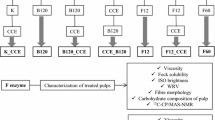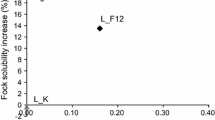Abstract
Dissolving grade pulps are used to manufacture regenerated cellulosic fibres. One promising process for the production of regenerated fibres utilises endoglucanse rich cellulases in the modification of dissolving pulp into alkaline soluble form. The aim of this paper was to characterise cellulases produced by Trichoderma reesei that are available in large quantities and study their effect on the dissolving grade softwood pulp, especially on its alkaline solubility. All the studied cellulases had endoglucanse activity and they decreased the intrinsic viscosity of the pulp. The degradation of cellulose into solubilised sugars increased with the cellulases containing also cellobiohydrolases. The monocomponent endoglucanases enhanced alkaline solubility of the pulp more than the multicomponent cellulases and produced alkaline solutions with higher fluidity. The studies showed that the type of the cellulases in the enzyme mixture has significant effect on the amount of solubilised sugars during the enzyme treatment and on the alkaline solubility of the pulp.










Similar content being viewed by others
References
Arantes V, Saddler JN (2011) Cellulose accessibility limits the effectiveness of minimum cellulase loading on the efficient hydrolysis of pretreated lignocellulosic substrates. Biotechnol Biofuels 4:3–18
Bailey MJ, Nevalainen KMH (1981) Induction, isolation and testing of stable Trichoderma reesei mutants with improved production of solubilizing cellulose. Enzyme Microb Technol 3:153–157
Bailey MJ, Biley P, Poutanen K (1992) Interlaboratory testing methods for assay of xylanse activity. J Biotechnol 29:257–270
Bailey MJ, Siika-aho M, Valkeajärvi A, Penttilä ME (1993) Hydrolytic properties of two cellulases Trichoderma reesei expressed in yeast. Biotechnol Appl Biochem 17:65–76
Bernfeld P (1955) Amylases, α and ß. In: Colowick SP, Kaplan NO (eds) Methods in enzymology, vol 1. Academic Press, New York, pp 149–158
Cao Y, Tan H (2002a) Effects of cellulase on the modification of cellulose. Carbohydr Res 337:1291–1296
Cao Y, Tan H (2002b) The properties of enzyme-hydrolyzed cellulose in aqueous sodium hydroxide. Carbohydr Res 337:1453–1457
Cao Y, Tan H (2006) Improvement of alkali solubility of cellulose with enzymatic treatment. Appl Microbiol Biotechnol 70:176–182
Carillo F, Colom X, Sunõl JJ, Saurina J (2004) Structural FTIR analysis and thermal characterisation of lyocell and viscose-type fibres. Eur Polym J 40:22229–22234
Cuissinat C, Navard P (2006) Swelling and dissolution of cellulose part II: free floating cotton and woof fibres in NaOH-water-additives systems. Mocromol Symp 244:19–30. doi:10.1002/masy.200651202
Cuissinat C, Navard P (2008) Swelling and dissolution of cellulose, part III: plant fibres in aqueous systems. Cellulose 15:67–74. doi:10.1007/s10570-007-9158-4
Engström AC, Ek M, Henriksson G (2006) Improved accessibility and reactivity of dissolving pulp for the viscose process: pretreatment with monocomponent endoglucanase. Biomacromolecules 7:2027–2031
Fock W (1959) A modified method for determining the reactivity of viscose-grade dissolving pulps. Papier (Bingen, Germany) 13:92–95
Ghose TK (1987) Measurement of cellulase activities. Pure Appl Chem 59:257–268
Grönqvist S, Hakala TK, Kamppuri T, Vehviläinen M, Hänninen T, Liitiä T, Maloney T, Suurnäkki A (2014) Fibre porosity development of dissolving pulp during mechanical and enzymatic processing. Cellulose 21:3667–3676. doi:10.1007/s10570-014-0352-x
Gwon JG, Lee SY, Doh GH, Kim JH (2010) Characterization of chemically modified wood fibers using FTIR spectroscopy for biocomposites. J Appl Polym Sci 116:3212–3219
Ibarra D, Köpcke V, Ek M (2010) Behavior of different monocomponent endoglucanases on the accessibility and reactivity of dissolving-grade pulps for viscose process. Enzyme Microb Technol 47:355–362
Isogai A, Atalla RH (1998) Dissolution of cellulose in aqueous NaOH. Cellulose 5:309–319
Kamide K, Okajima K, Matsui T, Kowsaka K (1984) Study on the solubility of cellulose in aqueous alkali solution by deuteration IR and 13C NMR. Polym J 16:857–866
Karlsson J, Medve J, Tjerneld F (1999) Hydrolysis of steam-pretreated lignocellulose. Appl Biochem Biotechnol 82:243–258
Karlsson J, Momcilovic D, Wittgren B, Schülein M, Tjerneld F, Brinkmalm G (2002) Enzymatic degradation of carboxymethyl celulose hydrolyzed by the endoglucanase Cel5A, Cel7B, and Cel 45A from Humicola Insolens and Cel7B, Cel12A and Cel45A core from Thrichoderma Reesei. Biopolymers 63:32–40
Kleman-Leyer KM, Siika-aho M, Teeri TT, Kirk TK (1996) The cellulases Endoglucanase I and cellobiohydrolase II of Thrichoderma reesei act synergistically to solubilize native cotton cellulose but not to decrease its molecular size. Appl Environ Microbiol 62:2883–2887
Köpcke V, Ibarra D, Ek M (2008) Increasing accessibility and reactivity of paper grade pulp by enzymatic treatment for use as dissolving pulp. Nord Pulp Pap Res J 23:363–368
Kotiranta P, Karlsson J, Siika-aho M, Medve J, Viikari L, Tjerneld F, Tenkanen M (1999) Adsorption and activity of Trichoderma reesei cellobiohydrolase I, endoglucanase II and the corresponding core proteins on steam pretreated willow. Appl Biochem Biotechnol 81:81–90
Laemmli UK (1970) Cleavage of structural proteins during assembly of the head of bacteriophage T4. Nature 227:680–685
Le Moigne N, Navard P (2010) Dissolution mechanisms of wood cellulose fibres in NaOH-water. Cellulose 17:31–45. doi:10.1007/s10570-009-9370-5
Le Moigne N, Jardeby K, Navard P (2010) Structural changes and alkaline solubility of wood cellulose fibers after enzymatic peeling treatment. Carbohydr Polym 79:325–332
Lowry OH, Rosenbrough NJ, Farr AL, Randall RJ (1951) Protein measurement with the Folin phenol reagent. J Biol Chem 23:265–275
Medve J, Karlsson J, Lee D, Tjerneld F (1998) Hydrolysis of microcrystalline cellulose by cellobiohydrolase I and endoglunace II from Trichoderma reesei: adsorption, sugar production pattern and synergism of the enzymes. Biotechnol Bioeng 59:621–634
Miao Q, Chen L, Huang L, Tian C, Zheng L, Ni Y (2014) A process for enhancing the accessibility and reactivity of hardwood kraft-based dissolving pulp for viscose rayon production by cellulase treatment. Bioresour Technol 154:109–113
Nakazawa H, Okada K, Kobayashi R, Kubota T, Onodera T, Ochiai N, Omata N, Ogasawara W, Okada H, Morikawa Y (2008) Characterization of the catalytic domains of Trichoderma reesei endoglucanases I, II, and III, expressed in Escherichia coli. Appl Microbiol Biotechnol 81:681–689
Nelson ML, O’Connor RT (1964) Relation of certain infrared bands to cellulose crystallinity and crystal lattice type. Part II. A new infrared ratio for estimation of crystallinity in cellulose I and II. J Appl Polym Sci 8:1325–1341
Nidetzky B, Steiner W, Hayn M, Claeyssens M (1994) Cellulose hydrolysis by the cellulases from Thrichoderma reesei: a new model for synergistic interaction. Biochem J 298:705–710
Orlowski A, Rog T, Paavilainen S, Manna M, Heiskanen I, Backfolk K, Timonen J, Vattulainen I (2015) How endoglucanase enzymes act on cellulose nanofibrils: role of amorphous regions revealed by atomistic simulations. Cellulose 22:2911–2925
Pu Y, Ziemer C, Ragauskas AJ (2006) CP/MAS 13C NMR analysis of cellulase treated bleached softwood kraft pulp. Carbohydr Res 341:591–597
Rahkamo L, Siika-aho M, Vehviläinen M, Dolk M, Viikari L, Nousiainen P, Buchert J (1996) Modification of hardwood dissolving grade pulp with purified Trchoderma reesei cellulases. Cellulose 3:153–163
Sandgren M, Shaw A, Ropp TH, Wu S, Bott R, Cameron AD, Ståhlberg J, Mitchinson C, Jones TA (2001) The X-ray crystal structure of the Trichoderma reesei family 12 endoglucanase 3, Cel12A, at 1.9 Å resolution. J Mol Biol 308:295–310
Suurnäkki A, Tenkanen M, Siika-aho M, Niku-Paavola ML, Viikari L, Buchert J (2000) Trichoderma reesei cellulases and their core domains in the hydrolysis and modification of chemical pulp. Cellulose 7:189–209
Tolan JS (2002) Iogen’s process for producing ethanol from cellulosic biomass. Clean Technol Environ Policy 3:339–345
Vehviläinen M, Kamppuri T, Rom M, Janicki J, Ciechanska D, Grönqvist S, Siika-aho M, Elg Christoffersson K, Nousiainen P (2008) Effect of wet spinning parameters on the properties of novel cellulosic fibres. Cellulose 15:671–680
Vehviläinen M, Kamppuri T, Grönqvist S, Rissanen M, Maloney T, Honkanen M, Nousiainen P (2015a) Dissolution of enzyme-treated cellulose using freezing-thawing method and the properties of fibres regenerated from the solution. Cellulose 22:1653–1674
Vehviläinen M, Kamppuri T, Setälä H, Grönqvist S, Rissanen M, Honkanen M, Nousiainen P (2015b) Regeneration of fibres from alkaline solution containing enzyme-treated 3-allyloxy-2-hydroxypropyl substituted cellulose. Cellulose 22:2271–2281
Virtanen T, Penttilä PA, Maloney TC, Grönqvist S, Kamppuri T, Vehviläinen M, Serimaa R, Maunu SL (2015) Impact of mechanical and enzymatic pretreatments on softwood pulp fibre wall structure studied with NMR spectroscopy and X-ray scattering. Cellulose 22:1565–1576. doi:10.1007/s10570-015-0619-x
Wang Y, Zhao Y, Deng Y (2008) Effect of enzymatic treatment on cotton fiber dissolution in NaOH/urea solution at cold temperature. Carbohydr Polym 72:178–184
Wang H, Pang B, Wu K, Kong F, Li B, Mu X (2014) Two stages of treatments for upgrading bleached softwood paper grade pulp to dissolving pulp for viscose production. Biochem Eng J 82:183–187
Acknowledgments
Funding from the Finnish Funding Agency for Technology and Innovation (TEKES) and Stora Enso Oyj are greatly acknowledged. The technical assistance of Maija Järventausta is gratefully acknowledged.
Author information
Authors and Affiliations
Corresponding author
Rights and permissions
About this article
Cite this article
Kamppuri, T., Vehviläinen, M., Backfolk, K. et al. Characterization of endoglucanase rich Trichoderma reesei cellulase mixtures and their effect on alkaline solubility of dissolving pulp. Cellulose 23, 3901–3911 (2016). https://doi.org/10.1007/s10570-016-1055-2
Received:
Accepted:
Published:
Issue Date:
DOI: https://doi.org/10.1007/s10570-016-1055-2




